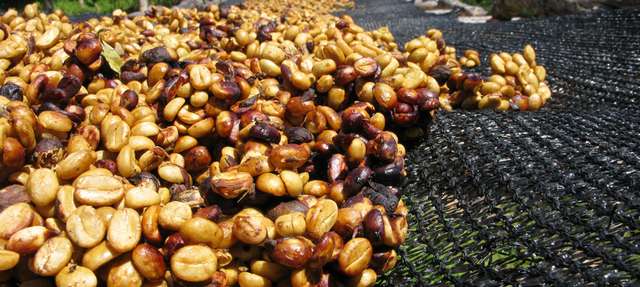与水洗处理法和日晒处理法两大传统处理方法并列,蜜处理方法也成为咖啡处理方法中的一支独秀。蜜处理即honey 或者miel,honey 即为蜂蜜的意思,miel是拉丁语中蜜的意思,所以这种方法的豆子总让人联想到香甜。在很多场合和条件下,似乎pluped natural 处理法也被视同为蜜处理,到底两者之间是否有区别,区别是大是小,Coffee Review给了我们进一步的说明,希望下面的一段摘自coffee review的文章能够让大家对密处理有更深入的认识。
咖啡处理方法:蜜处理
Honey and Pulped Natural Coffees
by Kenneth Davids; Reviews by Kenneth Davids with Jason Sarley
“Honey” is a relatively new term describing coffee that has been dried with all or some of the sticky fruit pulp or “honey” (miel in Spanish) still adhering to the bean. Those familiar with coffee processing methods will, of course, recognize this practice as a kind of compromise between two more familiar processing methods: the dry or “natural” method, in which the beans are dried while entirely encased inside the fruit, and the wet or “washed” method, in which all of the soft fruit residue, both skin and pulp, are scrubbed off before the coffee is dried. Like all variations in processing method, honey processing profoundly impacts cup character, which is doubtless the main reason producers, particularly in Central America, have been experimenting with it. All of the nineteen honey coffees we cupped for this article appear to have been specially prepared small-lot coffees intended to excite the high-end specialty market. Judging from our sampling, what can a coffee lover expect from these experiments?
Something Different
These honey coffees did not dramatically or spectacularly deviate from the “washed” or wet-processed sensory norm for fine coffee, but they did deviate. They were rounder in acidity, with less citrusy brightness and more chocolate, more aromatic wood, and generally a bit more sweetness.
Something Less Predictable
These honey samples not only were different from the wet-processed norm generally, but they also were quite different from one another. All of the honey samples we cupped this month originated in Central America: El Salvador, Costa Rica and Nicaragua. Had we cupped the same number of conventional wet-processed coffees from these same origins, we surely would not have experienced as rich and diverse a set of sensory expressions as we did with these honey coffees.
In part this may be because sensory expectations are clearly established for wet-processed, high-grown coffees from Central America, and producers, graders, exporters and importers all tend to essentially edit coffees to make sure they fit these clearly defined expectations. No such clear expectations have been established for honey coffees, allowing producers an open playing field for their experiments. Not that any of the samples we received showed clear sign of taint. In fact, overall these honey samples were remarkably free from taint and consistently agreeable, although agreeable in diverse ways.
For example, the El Salvador Casas de Lamina from Temple Coffee (92), with its hint of brandyish fruit ferment overlaying a cherryish dark chocolate, suggested a quieter, more restrained version of fruity natural-processed coffees. On the other hand, the Caffe Ladro El Salvador La Roxanita (92) was richly dry and tartly sweet, a structure we might expect from a wet-processed coffee, though the intense chocolate-toned richness I suspect derives from the deepening and rounding impact of the honey processing method. The El Salvador El Rubi Honey from Klatch Coffee (91) was lushly, almost heavily floral in character and quiet in acidity, both characteristics that we might expect to be intensified by the honey process. Finally, the Nicaragua Plantio el Aserradero from Velton’s Coffee (90) came across as a trans-oceanic variation of the earth and fruit Sumatra wet-hulled cup, though a delicate and unusual variation with its doubtless process-related molasses and wet woodsy notes.
All of the Honey vs. Some of the Honey
I suspect these differences mainly derive from variations in how the coffees were dried. But they also relate to an essential variable in how the honey process is conducted. As pioneered in Brazil about fifteen or twenty years ago the “pulped natural” process, as the Brazilians called it, simply involved removing the skins from the fruit and allowing the coffee to dry with virtually all of the fruit pulp (not to mention bits of skin) still sticking to the beans. Today in both Brazil and Central America this simple method remains the norm for the honey/pulped natural process, and I suspect that the great majority of the samples we reviewed this month were prepared using this straightforward approach.
However, the honey process has been nuanced over the last few years through use of machines called mechanical demucilagers. These machines are mainly designed to squeeze or scrub all of the fruit pulp or mucilage off freshly skinned beans, making them mechanized substitutes for the traditional “ferment and wash” method in which the pulp is first softened through natural ferment and then washed off the beans using moving water. Producers discovered that they could use some styles of demucilaging machine to remove some but not all of the mucilage before drying the beans. In at least one mill in Costa Rica, for example, honey coffees are either called “red” (all of the mucilage is allowed to dry on the beans, turning them reddish) or “yellow” (some of the mucilage is removed by machine and the coffee dries toward a dark yellow color) We do have an explicitly described “yellow” honey coffee reviewed here, the subtle, balanced Costa Rica El Espino Yellow Honey Caturra from Willoughby’s Coffee (89). Contrast this profile with the more robust and idiosyncratic profiles for the Klatch El Rubi and the Temple Casa de Lamina, for example, and I suspect you will have a sound beginning point for reading differences in these two honey variations as producers continue to explore and refine this richly promising approach to crafting sensory variation in fine coffee.

本站推荐:
耶加雪菲
花魁咖啡
瑰夏咖啡
波旁咖啡
蓝山咖啡
天堂鸟咖啡豆
曼特宁咖啡豆
PWN黄金曼特宁
星巴克菜单
咖啡豆种类
转载请注明出处。
2016-07-14 15:58:56


 相关文章
相关文章 网友点评
网友点评 精彩导读
精彩导读 热门资讯
热门资讯 关注我们
关注我们